中国历史文化英文选译共18页文档
中国历史文化英文选译

唐代文化
• 唐代文化是中国文化的一个高峰。尤其是 古典诗歌到唐代发展到全盛时期。在唐代 300余年的历史中,产生的流传于后世的 诗歌就有48,900多首。如此丰富的作品也 使2,300 多位诗人在历史上留下了他们的 名字。
• The Tang Dynasty witnessed a peak in Chinese culture. Especially, ancient poetry flourished in the Tang Dynasty. In more than 300 years of the Tang Dynasty, some 48,900 poems were handed down and remain widely known today. So many works also made more than 2,300 poets famous in history.
• 童年时曾随父母游历了名山大川,这培养了她的 眼界和才干。她 14 岁入宫,在经历了很多坎坷和 磨难之后,终于当上了皇后。
• She had visited famous mountains and great rivers with her parents when she was a child, which had broadened her horizon and developed her talents. She was sent to the palace when she was 14. After many difficulties and hardships, she became the empress finally.
• 690 年,武则天改国号(the title of the dynasty)唐为周,正式做了皇帝。她执政 期间,经济、文化繁荣发展,边疆稳固, 人民生活幸福。
古代中国文化英语版

古代中国文化英语版Ancient Chinese CultureChina, with its rich history spanning thousands of years, has a unique and vibrant ancient culture that continues to captivate people around the world. From its distinct philosophy to its magnificent art and architecture, Chinese culture offers a treasure trove of knowledge and wisdom. In this article, we will delve into various aspects of ancient Chinese culture, providing an overview of its key elements in an accessible and concise manner.1. Philosophy:At the heart of ancient Chinese culture lies a profound philosophical tradition that includes Confucianism, Daoism, and Buddhism. Confucianism emphasizes the importance of ethics, social harmony, and filial piety. Daoism promotes living in harmony with nature and cultivating the Dao, or the Way. Buddhism, originating in India but deeply integrated into Chinese culture, teaches the path to enlightenment and compassion towards all living beings. These philosophies have shaped the moral and ethical values of Chinese society for centuries.2. Language and Writing:The Chinese language, with its distinctive characters, is one of the oldest and most complex writing systems in the world. Each character represents a concept or idea and is composed of various strokes that must be written in a specific order. The Chinese writing system has played a crucial role in preserving ancient literature, historical records, and philosophical teachings.Chinese calligraphy, the art of writing beautifully, is highly regarded and often considered a meditative practice.3. Literature and Poetry:Chinese literature boasts a rich tradition that encompasses various genres, including poetry, prose, novels, and dramas. Ancient Chinese poets, such as Li Bai and Du Fu, created timeless verses that continue to inspire readers worldwide. Poems were often written with delicate imagery and profound emotions, capturing the beauty of nature and expressing the complexities of human experience. Classics, such as "The Romance of the Three Kingdoms" and "Journey to the West," provide a glimpse into ancient Chinese society and its values.4. Music and Performing Arts:Music has always held a significant place in Chinese culture. Traditional Chinese music, with its distinct instruments such as the guqin and pipa, evokes a sense of tranquility and elegance. The performing arts, including opera and dance, combine music with visually stunning movements and elaborate costumes. Peking Opera, with its unique vocal techniques and stylized gestures, is a highly esteemed art form that showcases the grandeur of ancient Chinese culture.5. Art and Architecture:Ancient Chinese art and architecture are characterized by their beauty, intricacy, and symbolism. Traditional Chinese painting, known for its use of ink and brush, captures the essence of nature and conveys emotions through minimalist strokes. The Forbidden City in Beijing and the TerracottaWarriors in Xi'an are iconic examples of Chinese imperial architecture, displaying the grandeur and power of ancient dynasties. The art of pottery, including delicate porcelain and vibrant ceramics, is also highly esteemed in Chinese culture.6. Medicine and Traditional Practices:Chinese medicine, with its holistic approach to health, has been practiced for thousands of years. Concepts such as Yin and Yang, as well as the flow of Qi (life energy), are central to traditional Chinese medicine. Acupuncture, herbal remedies, and tai chi are all part of this ancient healing tradition. Traditional practices, such as Feng Shui (the arrangement of space to promote harmony and balance) and Qigong (a practice combining movement, meditation, and breath control), are still widely followed today.In conclusion, ancient Chinese culture is a vast and diverse tapestry woven with philosophy, literature, art, and traditional practices. Its influence can be felt in various aspects of modern Chinese society and has captivated people worldwide. By understanding and appreciating this rich cultural heritage, we can gain valuable insights into the wisdom and traditions that have shaped China throughout history.。
中国悠久历史文化 英文版介绍

中国悠久历史文化英语介绍1China, a land with a long and rich history, has a cultural heritage that is both profound and diverse. Its history spans thousands of years, shaping the nation and leaving an indelible mark on the world.One of the most significant contributions of ancient China to the world was the Four Great Inventions: papermaking, gunpowder, printing, and the compass. Papermaking provided a convenient medium for recording and spreading knowledge. Gunpowder revolutionized warfare and had a profound impact on the course of history. Printing facilitated the dissemination of information and the preservation of cultural achievements. The compass enabled navigation and exploration, opening up new horizons for human civilization.Confucianism, another crucial element of Chinese culture, has had a profound influence on the values and social order of the Chinese people. It emphasizes moral integrity, respect for elders and authority, and the pursuit of harmony in society. This ideology has guided people's behavior and interpersonal relationships for centuries, fostering a sense of community and responsibility.Chinese calligraphy and painting are also remarkable manifestations of the country's cultural depth. The strokes and forms in calligraphy conveynot only beauty but also the spirit and personality of the artist. Traditional Chinese paintings, with their unique styles and themes, reflect the harmony between humans and nature.The architecture of ancient China, such as the Forbidden City and the Great Wall, stands as a testament to the nation's engineering prowess and aesthetic pursuit. These structures not only showcase the technical skills of the past but also tell the stories of different dynasties and the people who lived in them.In conclusion, China's long history and culture are a treasure trove of wisdom and creativity, continuing to inspire and fascinate people around the world.2China, a land of ancient civilization, possesses a history and culture that have endured for thousands of years. The charm and value of this rich heritage are truly remarkable.Take the traditional architectural style, for instance. The Forbidden City stands as a magnificent testament to China's architectural prowess. Its grand palaces, elaborate rooftops, and exquisite decorations showcase the sophistication and elegance of ancient craftsmanship. The symmetrical layout and imposing structures not only display the power and authority of the emperors but also reflect the harmony and order cherished in Chinese culture.Another aspect that highlights China's historical and cultural depth is its traditional festivals. The Spring Festival, filled with joy and celebration, is a prime example. Families come together, houses are adorned with red lanterns and couplets, and firecrackers explode to drive away evil spirits. Behind this festivity lies a profound cultural connotation. It symbolizes the renewal of life, the reunion of families, and the hope for a prosperous year ahead.The traditional Chinese culture is like a vast ocean, encompassing various elements such as philosophy, literature, art, and music. Confucianism and Taoism have shaped the values and thinking patterns of generations. Ancient literary works like "The Dream of the Red Chamber" and "Journey to the West" continue to inspire and fascinate.In conclusion, China's long history and culture are not only a precious heritage but also a source of inspiration and wisdom for the entire world. They have shaped the identity of the Chinese nation and continue to exert a profound influence on global civilization.3China, a land with a long and splendid history, has a cultural heritage that is both profound and diverse. The inheritance and development of this rich cultural legacy have been a continuous process.In modern society, various measures have been taken to protect traditional culture. For instance, many ancient buildings and historical siteshave been meticulously restored and maintained. Special funds are allocated for the preservation of intangible cultural heritages such as traditional handicrafts and folk art forms.Moreover, the integration and innovation of traditional culture with modern technology have brought about remarkable achievements. Digital technology has enabled the virtual restoration of ancient paintings and calligraphy, allowing people to appreciate these masterpieces in a new way. E-commerce platforms have provided a broader market for traditional handicrafts, making them accessible to more people.The traditional Chinese festivals, like the Spring Festival and Mid-Autumn Festival, have also adapted to modern times. Online celebrations and virtual gifts have become common, while the essence and meaning of the festivals remain unchanged.In conclusion, the long history and culture of China are not only being passed down but also evolving and thriving in the modern era. We should cherish and continue to promote this precious heritage for future generations.4China has a long and rich history and culture that is deeply reflected in our daily lives. Let's take a look at some aspects.When it comes to the eating habits of the Chinese people, there are numerous cultural traditions. For instance, during the Spring Festival,families come together to enjoy dumplings, symbolizing reunion and good fortune. The use of chopsticks in dining is not just a tool but also a part of our cultural heritage, emphasizing balance and harmony.Chinese traditional art forms, such as calligraphy and painting, are widely popular among the people. Calligraphy, with its elegant strokes and profound meanings, is not only an art but also a way to express one's thoughts and emotions. Many people practice calligraphy as a form of relaxation and self-cultivation. Paintings, whether they are landscapes or figures, often convey the artist's perception of nature and life, reflecting the Chinese people's pursuit of beauty and harmony.In traditional architecture, we can see the influence of history and culture. The design of ancient palaces and gardens shows the exquisite craftsmanship and unique aesthetic concepts of the Chinese. The layout and structure of these buildings follow certain principles and rules, embodying the wisdom and philosophy of our ancestors.In conclusion, China's long history and culture are alive and well in our daily lives, influencing and shaping our way of thinking, behaving, and creating. We should cherish and inherit these precious cultural treasures, allowing them to continue to shine in the modern world.5China has a long and splendid history and culture that has made remarkable contributions to the global cultural landscape. The Chinese teaculture, for instance, has spread far and wide across the world. It is not merely a beverage but a symbol of tranquility, hospitality, and refined taste. People in different countries have embraced the art of tea drinking, incorporating it into their daily lives and social gatherings.Chinese ancient literary works have also gained international acclaim. The classic novel "Dream of the Red Chamber" presents a vivid portrait of Chinese society and human nature, captivating readers with its intricate plot and profound insights. Another masterpiece, "Journey to the West," has inspired countless adaptations and has become a source of inspiration for storytellers worldwide.The philosophy of Confucius has had a profound impact on moral and ethical thinking in many cultures. Its teachings on respect, harmony, and the pursuit of knowledge have been widely studied and appreciated.The traditional Chinese architecture, with its unique style and exquisite craftsmanship, showcases the wisdom and creativity of the Chinese people. From the magnificent palaces to the elegant gardens, they stand as testaments to China's rich cultural heritage.In conclusion, China's long history and culture have not only shaped the nation but have also enriched the world, fostering cross-cultural understanding and appreciation.。
中国历史文化英语单词
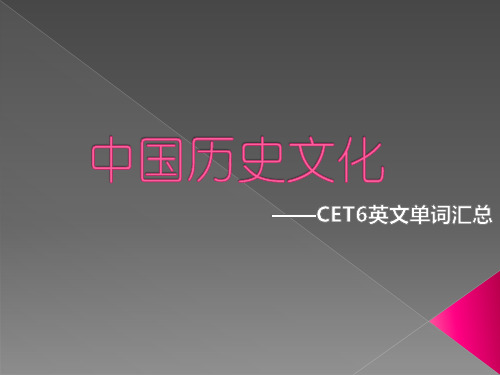
长征 the Long March 西安事变 Xi"an Incident 南京大屠杀Nanjing Massacre 抗日战争 the War of Resistance Against Japan 毛泽东 Mao Tse-tong 孙中山 Sun Yat-sen 蒋介石 Chiang Kai-shek 国民党 Kuomingtang 中华人民共和国 the People’s Republic of China (PRC) 满族 Manchu 蒙古人Mongol 士大夫 scholar-officials 学者 scholar 诗人 poet 政治家statesman
社会地位social status
1.不可分割的一部分:可译为an integral part。 2.为振兴华夏做出了巨大的贲献:可译为has made great contributions to the prosperity of China,其中“华夏”: 即“中国”或“Байду номын сангаас华”,可直接译为China; “振兴”此处翻译 成了名词形式prosperity,还可译为revitalization;“做出了 巨大 的贡献”可译为 has made great contributions。 3.并驾齐驱:此处指两者(中医和西医)都得以应用,可简 单地翻译为both are being used。 4.独特的诊断手法、系统的治疗方式和丰富的典籍材料: 三个并列的名词短语,可分别译为unique : I diagnostic methods, systematic approach和abundant historical literature and materials; “典籍材料”可理解为历史文献资料, 翻译为historical literature and materials。 5.引导并促进这一新兴产业的研究和开发:“引导”译为 guide; “促进”可译为promote,还可译为facilitate或 further; “新兴产业,,可译为promising industry,还可译为 new industry或emerging industry。 6.中医疗法:译为Chinese medication。
中国历史简介英文(16页)
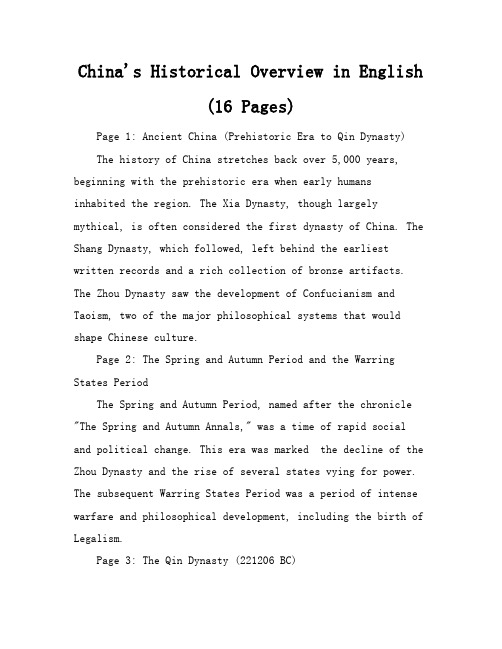
China's Historical Overview in English(16 Pages)Page 1: Ancient China (Prehistoric Era to Qin Dynasty)The history of China stretches back over 5,000 years, beginning with the prehistoric era when early humansinhabited the region. The Xia Dynasty, though largely mythical, is often considered the first dynasty of China. The Shang Dynasty, which followed, left behind the earliest written records and a rich collection of bronze artifacts. The Zhou Dynasty saw the development of Confucianism and Taoism, two of the major philosophical systems that would shape Chinese culture.Page 2: The Spring and Autumn Period and the Warring States PeriodThe Spring and Autumn Period, named after the chronicle "The Spring and Autumn Annals," was a time of rapid social and political change. This era was marked the decline of the Zhou Dynasty and the rise of several states vying for power. The subsequent Warring States Period was a period of intense warfare and philosophical development, including the birth of Legalism.Page 3: The Qin Dynasty (221206 BC)The Qin Dynasty, though shortlived, was pivotal in Chinese history. Qin Shi Huang, the first emperor of aunified China, standardized the writing system, currency, and measurements. He also began construction of the Great Wall and the Terracotta Army, which continues to astound visitors today.Page 4: The Han Dynasty (206 BC AD 220)The Han Dynasty is often cited as one of the golden ages of Chinese history. It saw the expansion of the Silk Road, which facilitated trade and cultural exchange with the West. The Han Dynasty also saw the development of Buddhism in China and the establishment of a civil service system based on merit.Page 5: The Three Kingdoms, Jin Dynasty, and the Southern and Northern DynastiesThe Three Kingdoms period, romanticized in the historical novel "Romance of the Three Kingdoms," was a time of fragmentation and warfare following the fall of the Han Dynasty. The Jin Dynasty reunified the north, but the country soon split again into the Southern and Northern Dynasties, leading to a period of cultural diversity and technological innovation.Page 6: The Sui Dynasty (581618)The Sui Dynasty, though shortlived, managed to reunify China. It is known for the construction of the Grand Canal, which linked the Yellow River and the Yangtze River, facilitating trade and transportation across the vast territory.Page 7: The Tang Dynasty (618907)The Tang Dynasty is renowned for its cultural achievements and economic prosperity. It is often referred to as the "Age of Unity andProsperity." The Tang Dynasty saw the flourishing of poetry, with poets like Li Bai and Du Fu, and the expansion of foreign trade along the Silk Road.Page 8: The Five Dynasties and Ten Kingdoms Period (907960)The Five Dynasties and Ten Kingdoms period was a time of political fragmentation. Despite the lack of a central authority, this era saw the continuation of cultural and economic developments, particularly in the south.(To be continued)Page 9: The Song Dynasty (9601279)The Song Dynasty is celebrated for its economicrevolution and cultural advancements. The era saw the early development of a market economy, the introduction of paper money, and remarkable innovations in agriculture and technology. The Song Dynasty also nurtured a flourishing ofthe arts, with landscape painting reaching new heights andthe philosophical school of NeoConfucianism gaining prominence.Page 10: The Yuan Dynasty (12711368)Established the Mongolian leader Kublai Khan, the Yuan Dynasty marked the first time that all of China was ruled nonHan Chinese. The Yuan Dynasty is notable for its patronage of the arts and its administrative organization, whichincluded the establishment of the Yuan Shikai, a precursor to modernday postal systems.Page 11: The Ming Dynasty (13681644)The Ming Dynasty is renowned for its maritime expeditions, notably those led the explorer Zheng He, which reached asfar as Africa and the Middle East. The dynasty is also famous for its architectural achievements, including theconstruction of the Forbidden City and the reinforcement ofthe Great Wall. The Ming era saw a flourishing of literature and drama, with the latter exemplified the works of Tang Xianzu.Page 12: The Qing Dynasty (16441912)The Qing Dynasty, established the Manchu people, was the last imperial dynasty of China. It reached its territorial zenith under Emperors Kangxi and Qianlong, expanding China's borders to include Tibet, Xinjiang, and Mongolia. However,the latter part of the dynasty was marked internal strife, foreign invasions, and the humiliating Boxer Protocol, leading to the decline of imperial power.Page 13: The Xinhai Revolution and the Republic of China The Xinhai Revolution of 1911 led to the overthrow of the Qing Dynasty and the establishment of the Republic of China under the leadership of Sun Yatsen. The early years of the republic were tumultuous, with warlordism and the strugglefor power between the Nationalist Party (Kuomintang) and the Communist Party.Page 14: The Chinese Civil War and the Establishment of the People's Republic of ChinaThe Chinese Civil War, which began in the late 1920s and ended in 1949, resulted in the victory of the Communist Party and the establishment of the People's Republic of China Mao Zedong. The new regime implemented sweeping land reforms and began the process of collectivization, which would have profound effects on Chinese society.Page 15: The Cultural Revolution and its AftermathThe Cultural Revolution, initiated Mao Zedong in 1966, was a radical sociopolitical movement aimed at purging remnants of capitalist and traditional elements from Chinese society. It led to widespread violence and the destruction of historical artifacts. The period following the CulturalRevolution was marked a shift towards economic reform and opening up to the world.Page 16: Modern China and the Path to the FuturePage 17: The Reform and Openingup PolicyDeng Xiaoping's leadership in the late 1970s brought about the Reform and Openingup Policy, which transformed China's economy from a centrally planned system to a market economy. This policy allowed foreign investment, established special economic zones, and encouraged private enterprise. The result was an economic boom that lifted hundreds of millions out of poverty and turned China into a global manufacturing hub.Page 18: The Rise of China's Tech GiantsPage 19: China's Space ExplorationChina's space program has made significant strides, including the successful launch of the Shenzhou spacecraft series and the construction of the Tiangong Space Station. In 2020, China became the second country to land a rover on the far side of the moon, demonstrating its ambition and capability in space exploration.Page 20: Environmental Challenges and Green InitiativesPage 21: Belt and Road InitiativeAnnounced in 2013, the Belt and Road Initiative is a global development strategy aimed at enhancing regionalconnectivity and economic integration. It involves infrastructure development and investments in countries across Asia, Europe, and Africa. The initiative reflects China's desire to take a more active role in global affairs and to expand its influence.Page 22: China's Role in Global DiplomacyChina has increasingly engaged in global diplomacy, playing a key role in international organizations such as the United Nations. It has also established strategic partnerships with countries around the world. However,China's assertiveness in regional disputes, particularly in the South China Sea, has raised concerns about its geopolitical intentions.Page 23: The Pursuit of Soft PowerRecognizing the importance of soft power, China has been promoting its culture and language through initiatives like the establishment of Confucius Institutes worldwide. These institutes offer Chinese language and cultural courses, contributing to the global spread of Chinese language and culture.Page 24: ConclusionChina's history is a tapestry of dynasties, revolutions, and rapid modernization. From the ancient dynasties that laid the foundation for Chinese civilization to the modern era oftechnological advancement and global engagement, China's story is one of resilience, innovation, and transformation. As China continues to evolve, its historical narrative will no doubt continue to influence its role on the world stage.。
中国历史文化概况(英文版)Unit 8 Traditional Holidays and Celeb
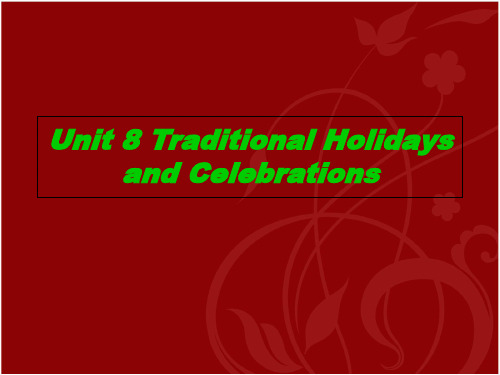
The time of the Mid-Autumn Festival
• The 15th day of every 8th lunar month is the traditional Chinese Mid-Autumn Festival. It is the most important festival after the Chinese Lunar New Year. The moon on the night of the 15th day of lunar August is believed to be fuller and brighter than in other months.
Staying up the whole night
on New Year's Eve
• Legend has it that in ancient times, there was a monster called "nian" or "year" that would harm people. Later, people found out that the monster routinely came out on New Year's Eve, so people began to get together on this day, staying up and chatting, hoping for peaceful passage of the time. The custom of staying up on New Year's Eve started in the South and North Dynasties, when people would stay up by the candle or oil lamp on New Year's Eve. The custom symbolizes the warding off of all diseases and disasters, wishing for good luck in the New Year.
研究生英语翻译-短文翻译(中国传统文化)
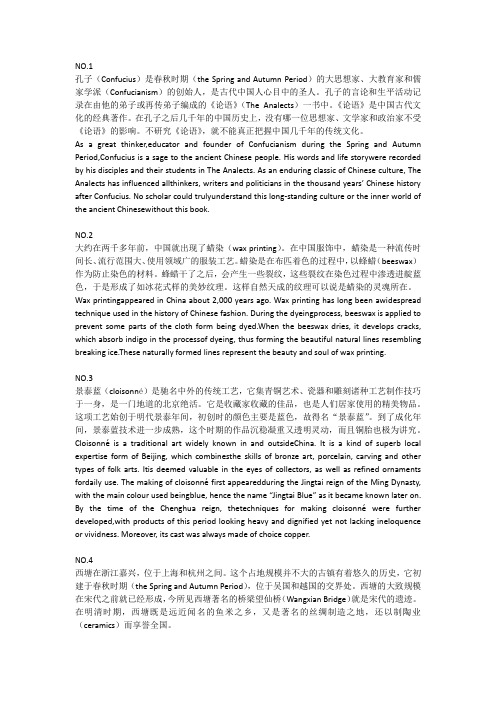
NO.1孔子(Confucius)是春秋时期(the Spring and Autumn Period)的大思想家、大教育家和儒家学派(Confucianism)的创始人,是古代中国人心目中的圣人。
孔子的言论和生平活动记录在由他的弟子或再传弟子编成的《论语》(The Analects)一书中。
《论语》是中国古代文化的经典著作。
在孔子之后几千年的中国历史上,没有哪一位思想家、文学家和政治家不受《论语》的影响。
不研究《论语》,就不能真正把握中国几千年的传统文化。
As a great thinker,educator and founder of Confucianism during the Spring and Autumn Period,Confucius is a sage to the ancient Chinese people. His words and life storywere recorded by his disciples and their students in The Analects. As an enduring classic of Chinese culture, The Analects has influenced allthinkers, writers and politicians in the thousand years’ Chinese history after Confucius. No scholar could trulyunderstand this long-standing culture or the inner world of the ancient Chinesewithout this book.NO.2大约在两千多年前,中国就出现了蜡染(wax printing)。
在中国服饰中,蜡染是一种流传时间长、流行范围大、使用领域广的服装工艺。
中国传统文化介绍(英文版)

栏目索引与介绍•当前位置: 主页/•中外文化/中国文化随着中国加入世界贸易组织,中国将进一步对外开放,中国经济与世界经济更加融合。
因此,将中华民族悠久的历史和灿烂的文化介绍给世界各国人民是所有英语爱好者应尽的责任。
开辟这个栏目,就是为了适应对外宣传的需要。
我们将在此介绍中国历史、音乐、绘画、考古、旅游、经济、宗教等方面的情况。
那些从事中国文化教学与研究的师生会在这里找到一些参考资料和英语表达方式。
中国文化知识漫谈(中文)中国文化美国行(新闻报道与背景介绍)Culture Relics文化古迹Travel Features旅游Wushu/Qigong武术与气功Opera/Theatre戏曲Galleries/Museums美术馆与博物馆Peking Opera中国京剧Events/Festivals节日与民俗Local Opera中国地方戏Chinese New Year's Day中国新年来历与24节气Dance Drama and Ballet中国舞剧与芭蕾Traditions of Chinese New Year中国新年除夕习俗Modern Chinese Drama中国话剧Do's and Don'ts of Chinese New Year 中国新年禁忌Acrobatics, Puppet and Shadow Shows杂技、木偶戏与皮影The History of Lion Dance中国舞狮Quyi Performances中国曲艺表演The History of Fireworks中国鞭炮Paintings/Handicrafts绘画与工艺品Lantern Festival元宵节成语典故一 (三国演义、西游记)Brithday of Confucius孔子生日成语典故二Birthday of Mazoo妈祖生日成语典故三Dragon Boat Festival端午节成语典故四Moon Festival中秋节中国古代简史中国文学(包括古文、近代、现代与当代文学以及文化传统,作家传记)中国诗歌英译 (请综合训练中翻译技巧栏目)中国旅游《旅游英语》网络课程中国旅游十大特色中国西藏北京景点天坛中国美食故宫中国十二生肖:12 Taditional Zodiacs M usic音乐RAM HORSE Solo Recordings中国音乐独奏MONKEY ROOSTER CollectedRecordings中国音乐集锦SNAKE DRAGON TraditionalChinese中国传统乐器与音乐InstrumentalmusicDOG PIG Classical Music中国古典音乐OX TIGERRABBIT RAT中国文化知识漫谈(一)文化的含义什么叫文化?《易经》上说:“观乎天文,以察时变,观乎人文,以化成天下。
段落汉译英(中国历史、文化、社会、经济参考词汇)

中国历史与文化京剧 Peking opera秦腔 Qin opera功夫 Kung fu太极 Tai chi口技 ventriloquism木偶戏 puppet show皮影戏 shadow play折子戏 opera highlights杂技 acrobatics相声 witty dialogue comedy刺绣 embroidery泥人 clay figure书法 calligraphy中国画 traditional Chinese painting水墨画 Chinese brush painting中国结 Chinese knot中国古代四大发明 the four great inventions of ancient China 火药 gunpowder印刷术 printing造纸术 paper-making指南针 the compass青铜器 bronze ware瓷器 porcelain;china唐三彩 tri-color glazed pottery of the Tang Dynasty景泰蓝cloisonné秋千 swing武术 martial arts儒家思想 Confucianism儒家文化 Confucian culture道教 Taoism墨家 Mohism法家 Legalism佛教 Buddhism孔子 Confucius孟子 Mencius老子 Lao Tzu庄子 Chuang Tzu墨子 Mo Tzu孙子 Sun Tzu象形文字 pictographic characters文房四宝(笔墨纸砚) the Four Treasures of the Study(brush, ink, stick, paper, and ink stone) 《大学》 The Great Learning《中庸》 The Doctrine of the Mean《论语》 The Analects of Confucius《孟子》The Mencius《孙子兵法》The Art of War《三国演义》Three Kingdoms《西游记》 Journey to the West《红楼梦》Dream of the Red Mansions《水浒传》Heroes of the Marshes《山海经》The Classic of Mountains and Rivers《资治通鉴》History as a Mirror《春秋》The Spring and Autumn Annals《史记》Historical Records《诗经》The Books of Songs《易经》The I Ching;;The Books of Changes《礼记》The Books of Rites《三字经》There-character Scriptures八股文eight-part essay五言绝句five-character quatrain七言律诗seven-character octave旗袍 cheongsam中山装Chinese tunic suit唐装 Tang suit风水 Fengshui;geomantic omen阳历 Solar calendar阴历 Lunar calendar闰年 leap year十二生肖 zodiac春节 the Spring Festival元宵节the Lantern Festival清明节the Tomb-sweeping Festival端午节 the Dragon-boat Festival中秋节 the Mid-autumn Day重阳节the Double-ninth Day七夕节the Double-seventh Day春联 spring couplets庙会 temple fair爆竹 firecracker年画(traditional)New Year pictures压岁钱 New Year gift-money舞龙 dragon dance元宵 sweet sticky rice dumplings花灯 festival lantern灯谜 lantern riddle舞狮 lion dance踩高跷 stilt walking赛龙舟 dragon boat race胡同 hutong山东幕 Shangdong cuisine川菜 Sichuan cuisine粤菜 canton cuisine扬州菜 Yangzhou cuisine月饼 moon cake年糕 rice cake油条 deep-fried dough sticks豆浆 soybean milk馒头 steamed buns花卷 steamed twisted rolls包子 steamed stuffed buns北京烤鸭 Beijing roast duck拉面 hand-stretched noodles馄饨 wonton(dumplings in soup)豆腐 tofu;bean curd麻花 fried dough twist烧饼 clay oven rolls皮蛋 100-year egg;century egg蛋炒饭 fried rice with egg糖葫芦 tomatoes on sticks火锅 hot pot长城 the Great Wall of China烽火台 beacon tower秦始皇陵 the Mausoleum of Emperor Qinshihuang 兵马俑 Terra cotta Warriors and Horses大雁塔 Big Wild Goose Pagoda丝绸之路 the Silk Road敦煌莫高窟 Mogao Grottoes华清池 huaqing Hot Springs五台山 Wutai Mountain九华山 jiuhua Mountain峨眉山 Mount Emei泰山 Mount Tai黄山 Mount Huangshan;the yellow Mountain故宫 the Imperial Palace天坛 the Temple of Heaven午门 Meridian Gate大运河 Grand Canal护城河 the Moat回音壁 Echo Wall居庸关 Juyongguan Pass九龙壁 the Nine Dragon Wall黄帝陵 the Mausoleum of Emperor Huangdi十三陵 the Ming Tombs苏州园林 Suzhou Gardens西湖 West Lake九寨沟 Jiuzhaigou Valley日月潭 Sun Moon Lake布达拉宫 Potala Palace鼓楼 drum tower四合院 quadrangle;courtyard complex孔庙 Confiicius Temple乐山大佛 Leshan Giant Buddha十八罗汉 the Eighteen Disciples of the Buddha喇嘛 Lama转世灵通 reincamated soul boy中药 traditional Chinese medicine针灸 acupuncture《黄帝内经》 Emperor Huangdi’s Canon of Traditional《神农本草经》 Shennong’s Herbal Classic《本草纲目》 Compendiwn of Materia Medica推拿 medical massage切脉 feeling the pulse五禽戏 five-animal exercises旧石器时代 the Paleolithic age新石器时代 the Neolithic Age;New Stone Age母系氏族社会 matriarchal clan society封建的 feudal朝代 dynasty秦朝 Qin Dynasty汉朝 Han Dynasty唐朝 Tang Dynasty宋朝 Song Dynasty元朝 Yuan Dynasty明朝 Ming Dynasty清朝 Qing Dynasty秦始皇帝 Emperor Qinshihuang;the First Emperor of Qin皇太后 Empress Dowager成吉思汗 Genghis Khan汉高祖刘邦 Liu Bang,Emperor Hangaozu,founder of the Han Dynasty 春秋时期 the Spring and Autumn Period文成公主 Tang Princess Wencheng慈禧太后 Empress Dowager Ci Xi皇帝,君主 emperor;monarch诸侯 vassal皇妃 imperial concubine丞相,宰相 prime minister太监 court eunuch少数民族 ethnic minority祭祀 offer sacrifices西域 the Western Regions战国 the Warring States中华文明 Chinese civilization文明的摇篮 cradle of civilization鸦片战争 the Opium War秦始皇统一中国 unification of the country by Emperor Qinshihuang 太平天国 the Taiping Heavenly Kingdom戊戌变法 the Reform Movement of 1898辛亥革命 the 1911 Revolution新民主主义革命 New-democratic Revolution五四运动 the May 4th Movement of 1919南昌起义 Nanchang Uprising918事变 September 18th Incident长征 the Long March西安事变 Xi’an Incident南京大屠杀 Nanjing Massacre毛泽东 Mao Tse –tong抗日战争 the War of Resistance Against Japan孙中山 Sun Yat-sen蒋介石 Chiang Kai-shek国民党 Kuomingtang满族 Manchu中华人民共和国 The People's Republic of China蒙古人 Mongol士大夫 scholar-officials学者 scholar政治家 statesman社会地位 social status中国社会多元文化论 cultural pluralism文化适应 acculturation社会保障 social security独生子女 the only child in a family搬迁户 a relocated unit or household班车 shuttle bus大龄青年 single youth above the normal matrimonial age青年 single parent福利彩票 welfare lotteries家政服务 household management service民工 migrant laborers名人 celebrity农村剩余劳动力 surplus rural labor青春期 puberty全民健身运动 nationwide fitness campaign全国人口普查nationwide census社会保障 social insurance暂住证 temporary residence permit/card青少年犯罪 juvenile delinquency性骚扰 sexual harassment走私 smuggling性别歧视 gender/sexual nationwide年龄歧视 age nationwide工作歧视 job nationwide享乐主义 hedonism文盲 illiteracy贫富分化 disparity between the rich and the poor盗版 pirated/illegal copies一国两制 One Country,Two Systems三个代表 the There Represents Theory南南合作 South- South Cooperation两会 Two Conferences南北对话 South-south Dialog人大常委会 People’s Congress Standing Committee法制观念 awareness of law改革开放 reform and opening-up法制国家 a country with an adequate legal system公务员 civil servants官僚主义作风 the bureaucratic style of work和谐并存 harmonious coexistence计划生育 family planning计划生育基本国策 the basic state policy of family planning精神文明建设 the construction of spiritual civilization居委会 neighborhood committee可持续发展 sustainable development科教兴国 national rejuvenation through science and education廉洁高效 honesty and high efficiency两岸关系 cross-straits relations两岸谈判 cross-straits negotiations领土完整 territorial integrity民族精神 national spirit普选制 general election system求同存异 seek common ground while shelving differences人大代表 NPC member小康社会 a well-off society物质文明和精神文明 material and spiritual civilization小康水平 a well-off standard一个中国原则 the one-China principle与时俱进 keep pace with the times综合国力 overall national strength共同愿望 common desire“走出去”战略 going global不结盟 non-alignment单边主义 unilateralism多变政策 multilateralism多极世界 multi-polar world人口老龄化 aging of population人口出生率 birth rate社区服务 community service道德法庭 court of ethics盗用公款 embezzlement成人夜校 night school for adults在职进修班 on-job training courses充电 update one’s knowledge政治思想教育 political and ideological education初等教育 elementary education大学城 college town大学社区 college community高等教育 higher education高等教育“211 工程” the“211 Project”for higher education 高等学府 institution of higher education综合性大学 comprehensive university文科院校 colleges of(liberal)arts理工科大学 college/university of science and engineering师范学院 teachers’ college;normal college高分低能 high scores and low abilities高校扩招 the college expansion pian高考(university/college)entrance examination教育界 education circle教育投入 input in education九年义务教育 nine-year compulsory education考研 take the entrance exams for postgraduate schools课外活动 extracurricular activities必修课 required/compulsory course选修课 elective/optional courses基础课 basic courses专业课 specialized courses课程表 school schedule教育大纲 teaching program;syllabus学习年限 period of schooling学历 record of formal schooling学分 credit启发式教学 heuristic teaching人才交流 talent exchange人才战 competition for talented people商务英语证书 Business English Certificate(BEC)适龄儿童入学率 enrollment rate for children of school age升学率proportion of student entering schools of a higher grade;enrollment rate硕博连读 a continuous academic project that involved postgraduate and doctoral study素质教育 quality-oriental education填鸭式教学 cramming method of teaching希望工程 Project Hope走读生 extern;non-resident student住宿生boarder研究生 graduate student;post-graduate(student)应届毕业生 graduating student;current year’s graduate毕业生分配 graduate placement;assignment of graduate校园数字化 campus digitalization校园文化 campus culture学汉语热 enthusiasm in learning Chinese学历教育 education with record of formal schooling学龄儿童 school-ager学前教育 preschool education学生减负 alleviate the burden on student应试教育 exam-oriental education职业道德 work ethics;professional ethics记者招待会 press conference国家教委 State Education Commission国家统计局 State Statistical Bureau职业培训 job training职业文盲 functional illiterate智力引进 recruit/introduce(foreign)talents智商 intelligence quotient(IQ)助学行动 activity to assist the impoverished students网络世界 cyber world网络文化 cyber culture网络犯罪 cyber crime网上购物 online shopping高产优质 high yield and high quality高科技园 high-tech park工业园区 industrial park火炬计划 Torch Program(a plan to develop new and high technology)信息港 info poet信息革命information revolution电子货币 e-currency人工智能 artificial intelligence(AI)生物技术 bio-technology克隆 cloning基因工程 genetic engineering转基因食品 genetically modified food(GM food)基因突变 genetic mutation网络出版 e-publishing三维电影 three-dimensional movie光谷 optical valley虚拟银行 virtual bank信息化 informationization信息高速公路 information superhighway新兴学科 new branch of science;emerging discipline nanometer纳米 nanometer个人数字助理 personal digital assistant(PDA)生态农业 environment-friendly agriculture技术密集产品 technology-intensive product数码科技 digital technology同步卫星 geostationary satellite神舟五号载人飞船 manned spacecraft Shenzhou V风云二号气象卫星 Fengyun II meteorological satellite登月舱 lunar module多任务小卫星 small multi-mission satellite(SMMS)多媒体短信服务 Multimedia Messaging Service(MMS)电子商务 e-business;e-commerce电子管理 e-management办公自动化 Office Automation(OA)信息高地 information highland信息检索 information retrieval电话会议 teleconference无土栽培 soilless cultivation超级杂交水稻 super-hybrid rice科技发展 scientific and technological advancement重点项目 key project国家重点工程 national key project南水北调 South-to-North water diversion西电东送 West-East electricity transmission project西气东输 West-East natural gas transmission project网络造谣 fabricating online rumors停止服务 closure/shutdown of service恶意侵害他人名誉 maliciously harming the reputation of others 公司歇业 closure of business道路封闭 road closure人为操作差错 man-made operational mistakes生态系统 ecosystem森林生态系统 forest ecosystem海洋生态系统 manne ecosystem垄断价格 to monopolize the price垄断市场 to monopolize/forestall/captive/corner the market 限构思用汽车 to curb the purchase of vehicles for private use 汽车限购vehicle purchase restrictions车牌摇号 a lottery for license plates拍照单双号限行 odd-even license plate system黑名单制度 a blacklist system二代身份证 2nd-generation ID cards执业医师 practicing physician ; licensed doctor防伪技术 anti-forgery technology非法交易 illegal transaction冒名顶替 identification fraud洗钱 money laundering挂失 to report the loss补办 to re-apply/post-register户籍 household registration居住证 residence permit山洪暴发 flash floods水位 water level低洼地区 low-lying areas淹没农田 to inundate crops大桥垮塌 bridge collapse直接经济损失 direct economic loss最严重受灾地区 worst-hit/worst-stricken area应急系统 emergency response system闯红灯 running red light遮挡、污损牌号 blocking or defacing license plates扣分处罚 point penalty酒驾 drunk driving终身禁驾 lifetime ban from driving中国经济总需求 aggregate demand总供给aggregate supply企业文化 corporate/entrepreneurial culture企业形象 corporate image(CI);enterprise image跨国公司 cross-national corporation创业精神 enterprising spirit;pioneering spirit外资企业 foreign-funded enterprise猪头公司 head-hunter假日经济 holiday economy人力资源 human capital航空和航天工业 aerospace industry飞机制造工业 aircraft industry电子工业 electronic industry汽车制造工业 car industry娱乐业 entertainment industry信息产业 information industry轻工业 light industry知识密集型产业 knowledge-intensive industry国有大中型企业 large and medium-sized state-owned en 博彩业 lottery industry制造业 manufacturing industry垄断行业 monopoly industry市场多元化 market diversification市场经济market economy市场监督 market supervision购买力 purchasing power熊市 bear market牛市 bull market城镇化 urbanization房地产 real estate首付 down-payment业主 home owner个人购房贷款 individual housing loan经济全球化economic globalization经济特区 special economic zones(SEZ)经济增长 economic growth泡沫经济 bubble economy关税 tariff纳税人 tax payer宏观经济 macro economy货币投放量 the size of money supply流动性过剩 excess liquidity经济过热 overheated economy通货膨胀 inflation抑制通货膨胀 curb inflation注入流动性 to inject liquidity贴现率 discount rate存款准备金率 reverse requirement ratio(RRR)公开市场业务 open market operation(OMO)逆回购 reverse repurchase agreement; reverse repo引导降低市场借贷成本 to guide the market borrowing costs to a lower level 稳健的货币政策 prudent monetary policy硬着陆 hard landing软着陆 soft landing二十国集团 Group of Twenty财政部长 Finance Minister全年预期经济增长目标 the expected growth for the whole year经济活力 economic vitality结构改革 structural reform大规模经济刺激计划 a massive economic stimulus package硬资产 hard assets软资产 soft assets有型资产 tangible assets经济走廊 economic corridor整顿市场秩序 to rectify the market order反垄断 antitrust; anti-monopoly定价浮动 price fluctuations债务审计 audit of debt谋求利益最大化 to maximize profit地方性政府债务 local government debt/liability公共财政体制改革 an overhaul of the public finance system债务管理 debt management信用支持 credit support。
中国文化概况英汉对照版
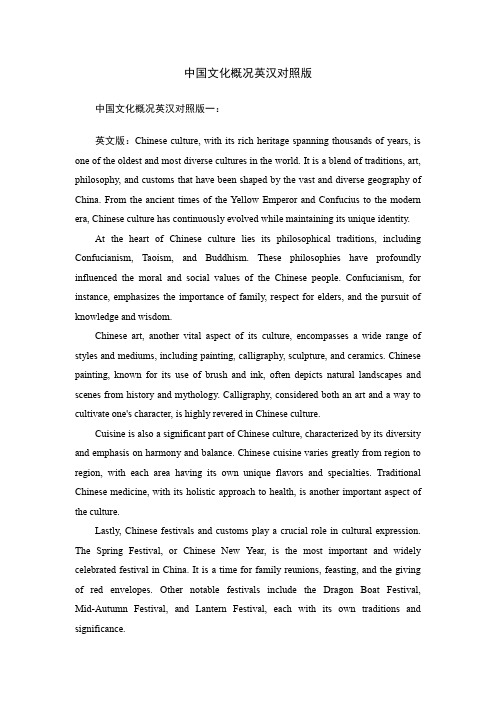
中国文化概况英汉对照版中国文化概况英汉对照版一:英文版:Chinese culture, with its rich heritage spanning thousands of years, is one of the oldest and most diverse cultures in the world. It is a blend of traditions, art, philosophy, and customs that have been shaped by the vast and diverse geography of China. From the ancient times of the Yellow Emperor and Confucius to the modern era, Chinese culture has continuously evolved while maintaining its unique identity.At the heart of Chinese culture lies its philosophical traditions, including Confucianism, Taoism, and Buddhism. These philosophies have profoundly influenced the moral and social values of the Chinese people. Confucianism, for instance, emphasizes the importance of family, respect for elders, and the pursuit of knowledge and wisdom.Chinese art, another vital aspect of its culture, encompasses a wide range of styles and mediums, including painting, calligraphy, sculpture, and ceramics. Chinese painting, known for its use of brush and ink, often depicts natural landscapes and scenes from history and mythology. Calligraphy, considered both an art and a way to cultivate one's character, is highly revered in Chinese culture.Cuisine is also a significant part of Chinese culture, characterized by its diversity and emphasis on harmony and balance. Chinese cuisine varies greatly from region to region, with each area having its own unique flavors and specialties. Traditional Chinese medicine, with its holistic approach to health, is another important aspect of the culture.Lastly, Chinese festivals and customs play a crucial role in cultural expression. The Spring Festival, or Chinese New Year, is the most important and widely celebrated festival in China. It is a time for family reunions, feasting, and the giving of red envelopes. Other notable festivals include the Dragon Boat Festival, Mid-Autumn Festival, and Lantern Festival, each with its own traditions and significance.汉语对照版:中国文化,拥有数千年的丰富遗产,是世界上最古老、最多样化的文化之一。
(完整版)中国文化英语翻译

Unit1 中国丝绸中国是丝绸的故乡。
栽桑、养蚕、缫丝、织绸是中国古代人民的伟大发明。
商周时期(前1600——前256)丝绸的生产技术就已发展到相当高的水平。
西汉(前206——公元25)时张蹇通西域,把中元与波斯湾、地中海紧密联系起来,开辟了中外交流贸易的新纪元。
从此中国的丝绸以其卓越的品质、精美的花色和丰富的文化内涵闻名于世,成为中国文化的象征、东方文明的使者。
Chinese SilkChina is the home of silk. Mulberry planting, sericulture, silk reeling and thickening are all great inventions of the ancient Chinese. As early as the Shang and Zhou Dynasties (1600-BC256BC), the Chinese people’s silk-weaving techniques had reached an extremely high level. During the Western Han Dynasty(206BC-25AD),Zhang Jian ,an outstanding diplomat ,traveled around central Asia and connected China with the Persian Gulf and the Mediterranean, opening up a new era of Sino-foreign trade, exchange and communication. From then on, China’s silk became well known for its extraordinary quality, exquisite design and color , and abundant cultural connotations. Hitherto, Chinese silk has been accepted as a symbol of Chinese culture and the emissary of oriental civilization.中国园林中国园林是把人造的山水、植物、建筑等与自然地貌有机结合的环境艺术,是我国古代建筑艺术的珍宝。
中国文化概况中英版
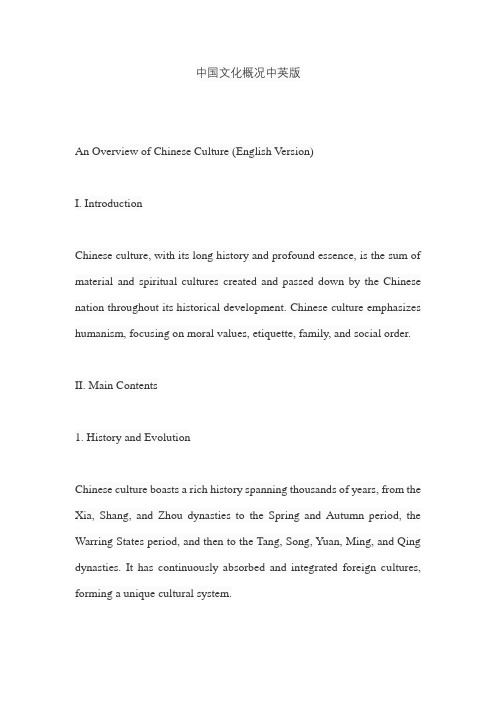
中国文化概况中英版An Overview of Chinese Culture (English Version)I. IntroductionChinese culture, with its long history and profound essence, is the sum of material and spiritual cultures created and passed down by the Chinese nation throughout its historical development. Chinese culture emphasizes humanism, focusing on moral values, etiquette, family, and social order.II. Main Contents1. History and EvolutionChinese culture boasts a rich history spanning thousands of years, from the Xia, Shang, and Zhou dynasties to the Spring and Autumn period, the Warring States period, and then to the Tang, Song, Yuan, Ming, and Qing dynasties. It has continuously absorbed and integrated foreign cultures, forming a unique cultural system.2. Traditional ValuesConfucianism is one of the cornerstones of Chinese culture, emphasizing virtues such as benevolence, filial piety, loyalty, and etiquette, which have profoundly influenced the behavior and values of the Chinese people. Taoism emphasizes the harmony between man and nature, advocating a natural and non-interventionist approach. Buddhism, on the other hand, emphasizes compassion and self-sacrifice, having a significant impact on Chinese religion and philosophy.3. Cultural Characteristics- Festival Culture: China has many traditional festivals, such as the Spring Festival, Mid-Autumn Festival, and Dragon Boat Festival, each with unique celebration methods and cultural connotations.- Clothing Culture: Traditional Chinese clothing, such as Hanfu and Tangzhuang, reflects the unique aesthetic concepts and cultural characteristics of the Chinese nation.- Architectural Culture: Traditional Chinese architecture, including palaces, temples, and gardens, is renowned for its distinctive styles and exquisite craftsmanship.- Cuisine Culture: Chinese cuisine, known for its rich flavors and exquisiteculinary techniques, is an important representation of China's cultural charm.4. Influence on the WorldThe values and ideological systems of Chinese culture have had a profound impact on the world, especially Confucianism, which has influenced Asia and beyond. Traditional Chinese arts and forms of expression, such as calligraphy, painting, and Peking Opera, are also deeply loved and admired by people around the world.III. ConclusionChinese culture is a treasure of the Chinese nation, embodying unique charm and value. Through learning and understanding Chinese culture, we can gain a deeper understanding of the history, traditions, and spiritual outlook of the Chinese people, further enhancing our sense of national pride and self-confidence. At the same time, Chinese culture has also made significant contributions to the diversity and development of world culture.中国文化概况中英版一、引言中国文化,源远流长,博大精深,是中华民族在长期历史发展过程中所创造并传承下来的物质文化和精神文化的总和。
中国历史文化概况(英文版)Unit 1 Origins and History

2. The Longshan culture (龙山文化) : a late Neolithic culture in China, centered on the central and lower Yellow River and dated from about 3000 BC to 2000 BC. The Longshan culture is named after the town of Longshan in the east of the area under the administration of the city of Jinan, Shandong Province, where the first archaeological find (in 1928) and excavation (in 1930 and 1931) of this culture took place at the Chengziya Archaeological Site.
5. Mencius (孟子) : an itinerant Chinese philosopher and sage, and one of the principal interpreters of Confucianism. Supposedly, he was a pupil of Confucius' grandson, Zisi. Like Cotravelled China for forty years to offer advice to rulers for reform. During the Warring States Period, Mencius served as an official and scholar at the Jixia Academy in the State of Qi. He expressed his filial devotion when he took an absence of three years from his official duties for Qi to mourn his mother's death. Disappointed at his failure to affect changes in his contemporary world, he retired from public life.
中国文化概况翻译
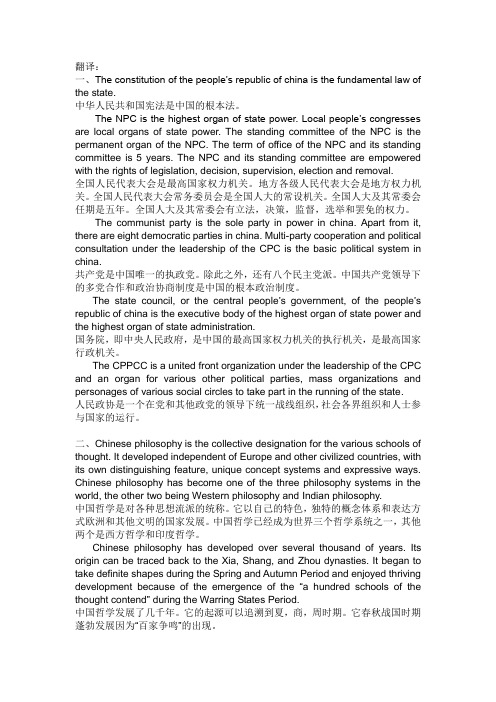
翻译:一、The constitution of the people’s republic of china is the fundamental law of the state.中华人民共和国宪法是中国的根本法。
The NPC is the highest organ of state power. Local people’s congresses are local organs of state power. The standing committee of the NPC is the permanent organ of the NPC. The term of office of the NPC and its standing committee is 5 years. The NPC and its standing committee are empowered with the rights of legislation, decision, supervision, election and removal.全国人民代表大会是最高国家权力机关。
地方各级人民代表大会是地方权力机关。
全国人民代表大会常务委员会是全国人大的常设机关。
全国人大及其常委会任期是五年。
全国人大及其常委会有立法,决策,监督,选举和罢免的权力。
The communist party is the sole party in power in china. Apart from it, there are eight democratic parties in china. Multi-party cooperation and political consultation under the leadership of the CPC is the basic political system in china.共产党是中国唯一的执政党。
- 1、下载文档前请自行甄别文档内容的完整性,平台不提供额外的编辑、内容补充、找答案等附加服务。
- 2、"仅部分预览"的文档,不可在线预览部分如存在完整性等问题,可反馈申请退款(可完整预览的文档不适用该条件!)。
- 3、如文档侵犯您的权益,请联系客服反馈,我们会尽快为您处理(人工客服工作时间:9:00-18:30)。
1、合法而稳定的权力在使用得当时很 少遇到 抵抗。 ——塞 ·约翰 逊 2、权力会使人渐渐失去温厚善良的美 德。— —伯克
3、最大限度地行使权力总是令人反感 ;权力 不易确 定之处 始5、虽然权力是一头固执的熊,可是金 子可以 拉着它 的鼻子 走。— —莎士 比
31、只有永远躺在泥坑里的人,才不会再掉进坑里。——黑格尔 32、希望的灯一旦熄灭,生活刹那间变成了一片黑暗。——普列姆昌德 33、希望是人生的乳母。——科策布 34、形成天才的决定因素应该是勤奋。——郭沫若 35、学到很多东西的诀窍,就是一下子不要学很多。——洛克
